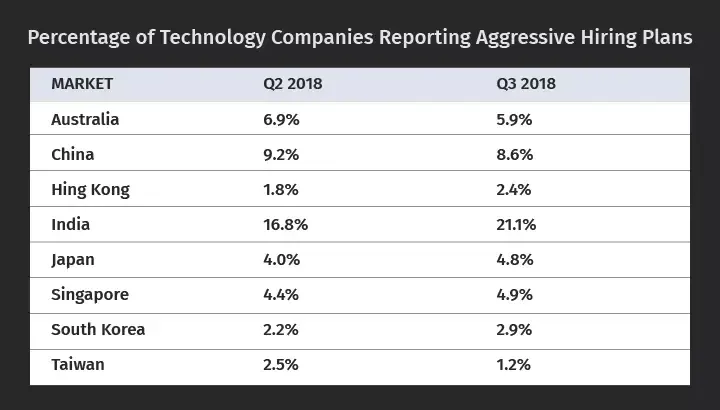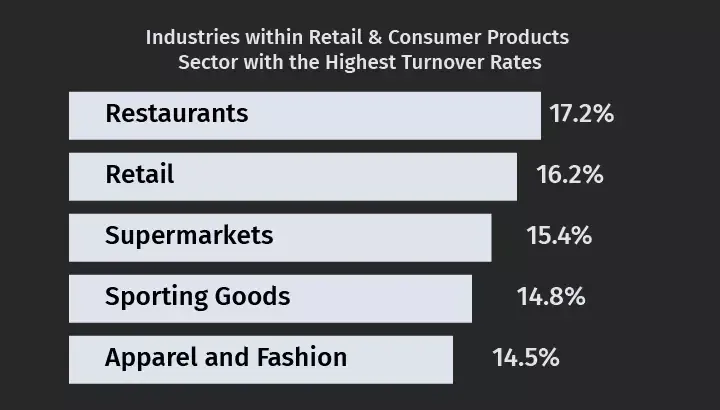Tingkat Perputaran Karyawan: Penyebab, Dampak, dan Cara Menguranginya
Pergantian karyawan yang tinggi dapat mengganggu produktivitas, meningkatkan biaya perekrutan, dan menurunkan semangat kerja.
Di halaman ini
- Apa yang dimaksud dengan pergantian karyawan?
- How to calculate employee turnover rate
- Average employee turnover rate by industry
- Apa arti sebenarnya dari pergantian karyawan yang tinggi?
- Penyebab pergantian karyawan di tempat kerja
- Bagaimana cara mengurangi pergantian karyawan?
- Measuring the true cost of employee turnover
- Reducing employee turnover with Empuls
- Intinya
The employee turnover rate reflects your company’s ability to retain talent. While some turnover is expected, excessive departures lead to productivity loss, hiring costs, and low morale. With job openings dropping to 8.7 million and separations holding at 5.6 million, businesses must focus on retention strategies.
A healthy turnover rate is around 10% or less, yet 75% of employers struggle to attract and retain top talent. High-performance companies keep top employees with an annual high-performer turnover rate as low as 3% or even zero.
But what drives employees to leave? From poor workplace culture to lack of career growth and work-life balance, the causes vary—but the impact is always significant.
This article explores the causes of employee turnover, how to measure it, and how to reduce employee turnover with practical strategies.
Apa yang dimaksud dengan pergantian karyawan?
Employee turnover is the number of employees who leave your company over a specific period, typically one year. Although employee turnover usually covers the total number of employees who leave a company, it can also be calculated per department or unit.
Employee turnover doesn’t just refer to employees leaving voluntarily from the company. For example, when an employee is fired due to poor performance or a bad attitude, that counts as employee turnover.
Only, it is involuntary. Some employee turnover is, therefore, inevitable. However, a sudden spike in employee turnover is not because it can be reflective of the bad workplace environment that prompts employees to leave in the first place.
Perusahaan dengan tingkat perputaran karyawan yang tinggi dianggap sebagai tempat yang buruk untuk bekerja. Akibatnya, perusahaan dengan reputasi buruk kesulitan untuk menarik talenta terbaik.
How to calculate employee turnover rate
Knowing if your business has a high employee turnover rate is crucial—it’s a key indicator of workplace culture and retention challenges. If your turnover is significantly higher than that of your competitors, you may lose the battle for top talent. Here’s how to calculate it accurately.
1.Turnover Rate Formula (SHRM Recommended):
Turnover Rate=(Average Number of Employees Number of Separations)×100
Identify employee departures: Count all separations (voluntary and involuntary) over a specific period.
Determine the average workforce: Add the number of employees at the start and end of the period, then divide by two.
Apply the formula: Divide the number of departures by the average number of employees and multiply by 100 to get the percentage.
Example employee turnover calculation:
Employees at the start: 200
Employees at the end: 180Employees who left: 20
Average number of employees: (200 + 180) / 2 = 190
Turnover rate: (20 / 190) × 100 = 10.5%
Turnover calculations aren’t always straightforward. You must decide how to account for part-time employees, temporary workers, and employees on leave. The SHRM Turnover Calculation Spreadsheet can simplify this process by ensuring accurate workforce calculations.
Why industry benchmarking matters
Your turnover rate doesn’t mean much unless you compare it to competitors. A "low" turnover rate might still exceed industry standards, signaling a retention problem. Researching average employee turnover rate by industry and location helps businesses understand where they stand and what improvements are needed.
Why employee turnover is a growing concern
Employee retention remains a challenge worldwide. Studies show that half of U.S. employees have considered leaving their current jobs, making it a competitive labor market. Businesses that fail to address turnover risk losing top talent to companies with better workplace culture and engagement strategies.
Tracking and analyzing turnover regularly is essential to improving employee satisfaction and reducing unnecessary attrition—ensuring your company remains a competitive employer of choice.
Average employee turnover rate by industry
Now that you know how to calculate the employee turnover rate, your next question is, what constitutes a low and high turnover rate? The answer will depend on your industry.
It’s difficult to give an ideal employee turnover rate because industry-specific factors also affect employee turnover. What I can give you, though, are the employee turnover jobs and high employee turnover industries.
Mari kita selami:
1. Teknologi
Tech has had the highest employee turnover rate in recent years. In 2017, it had a 13.2% turnover, according to a LinkedIn study. That’s 0.2% more than the employee turnover rate for retail (more on this later). In previous years, retail had consistently been at the top of the list of industries with the highest employee turnover.
Within the tech industry, some industries have shown the highest turnover rates:
There are specific high-turnover jobs, too. For example, the job of user experience and designer had a turnover rate of 23.3%. This was followed by the data analyst post and the embedded software engineer post, with 21.7% each. However, the high employee turnover rates in the technology industry, in general, may have more to do with staff competition.
Seiring dengan meningkatnya persaingan di sektor ini untuk memperebutkan sumber daya yang langka, perusahaan menawarkan gaji dan tunjangan yang lebih kompetitif untuk bersaing, yang mendorong beberapa karyawan untuk pindah ketika mereka menemukan peluang yang lebih baik.

The table above from the Radford Global Technology Survey Quarterly Workforce Trends Report shows that, in particular, there has been a spike in the number of companies looking to hire aggressively, particularly in India, where the technology sector is booming.
Dengan kata lain, meskipun ada tingkat pergantian yang tinggi di beberapa bidang teknologi, karyawan yang keluar masih mendapatkan pekerjaan di industri teknologi.
2. Industri ritel dan produk konsumen
Historically, the retail and consumer products industry has had a high employee turnover rate. According to the LinkedIn survey, within the retail sector, restaurants had the highest turnover rate, at 17.2%:

Dalam industri ritel, tenaga penjualan ritel memiliki tingkat perputaran tertinggi, yaitu 19,3%, diikuti oleh tenaga profesional di bidang layanan makanan, yaitu 17,6%, dan tenaga profesional di bidang perhotelan, yaitu 17,0%.
Although it’s hard to say the main reasons for employee turnover in the industry, the fact that the jobs with the highest turnover are low-level and seasonal may explain a lot. Also, the rise of eCommerce in retail means that fewer people are needed in-store.
This is because many traditional retail functions have been digitized and automated. Online shopping, self-checkout kiosks, and automated inventory management through distribution ERP software have reduced the need for as many in-store staff.
3. Industri media dan hiburan
The employee turnover rates in the media and entertainment sectors are constant.
Baik itu surat kabar, media online, olahraga, atau perjalanan dan pariwisata, tingkat pergantian karyawan pada dasarnya sama menurut LinkedIn: dari 13% hingga 13,2%.
Hal yang sama juga berlaku untuk pekerjaan di sektor film. Animator memiliki tingkat pergantian karyawan tertinggi, yaitu 25,6%, diikuti oleh seniman 3D, yaitu 22,3%. Spesialis pemasaran berada di posisi ketiga, dengan tingkat pergantian karyawan 19,8%.
Pekerjaan dengan perputaran yang tinggi berdasarkan data sebagian besar berbasis proyek (atau memiliki awal dan akhir yang jelas, tergantung pada durasi syuting film, misalnya).
Tingkat pergantian yang tinggi dapat menjelaskan eksodus karyawan. Jika demikian, statistik ini harus diperlakukan dengan hati-hati, karena ini bukan pengukuran yang akurat untuk pergantian karyawan.
Apa arti sebenarnya dari pergantian karyawan yang tinggi?
Ada banyak sekali alasan mengapa karyawan meninggalkan organisasi Anda dengan kecepatan tinggi - ini bisa berbeda untuk setiap bisnis. Namun ada beberapa faktor umum yang perlu Anda perhatikan yang sering menyebabkan karyawan keluar.
1. Kompensasi atau tunjangan yang buruk
Jika karyawan Anda bekerja sama kerasnya dengan pesaing Anda, namun mereka tidak mendapatkan gaji atau tunjangan yang sama, itu adalah alasan besar bagi mereka untuk pergi. Dan dengan popularitas situs seperti Glassdoor, karyawan saat ini memiliki banyak wawasan tentang apa yang diperoleh rekan-rekan mereka di organisasi lain.
Bagaimanapun juga, karyawan menerima pekerjaan karena berbagai alasan, namun yang paling penting adalah menghasilkan uang untuk menghidupi diri sendiri dan keluarganya. Jika mereka merasa tidak dapat melakukannya bersama Anda atau merasa lebih baik di tempat lain, mereka akan lebih cenderung pergi.
2. Budaya tempat kerja yang negatif
Are your employees stressed out, overloaded with work, unappreciated, or subject to too much unhealthy competition? The culture of your workplace has a significant impact on employee retention.
Jika karyawan merasa organisasi Anda menunjukkan melalui budaya tempat kerja Anda bahwa Anda tidak peduli dengan mereka sebagai manusia, mereka mungkin akan segera keluar. Hal ini bisa berarti budaya kerja yang berlebihan, kurang menghargai, dan budaya yang tidak memiliki batasan, sehingga karyawan bekerja sepanjang waktu atau budaya perilaku yang tidak menyenangkan atau berbahaya.
Karyawan menghabiskan sebagian besar waktu mereka di tempat kerja - sudahkah Anda menciptakan budaya yang mendukung agar karyawan dapat melakukan pekerjaan terbaik mereka atau budaya yang membuat mereka tidak sabar untuk segera pulang di penghujung hari?
3. Kesempatan karier yang buruk
Anda mungkin memiliki gaji yang kompetitif dan budaya tempat kerja yang bagus, namun Anda melihat karyawan masih sering keluar lebih sering dari yang Anda inginkan - ada apa? Bisa jadi karena kurangnya peluang karier. Jika karyawan tidak merasa ada jalan untuk sukses jangka panjang di perusahaan Anda, itu tidak terlalu menggembirakan.
Mereka menginginkan kesempatan untuk mempelajari keterampilan baru, menghadapi tantangan baru, dan mengembangkan karier mereka. Bukan berarti Anda harus mempromosikan setiap karyawan setiap tahun - itu bukan harapan yang masuk akal.
Namun, hal ini dapat membantu Anda untuk melihat dengan cermat rencana pengembangan karier dan peluang yang Anda sediakan untuk karyawan - apakah ada ruang untuk perbaikan, terutama untuk talenta yang paling menjanjikan? Membantu mereka melihat masa depan yang jelas dan rencana untuk mencapainya dapat mendorong karyawan berbakat untuk bertahan dan terus berkontribusi pada bisnis Anda.
4. Ketika omset sehat
Meskipun begitu - tidak semua pergantian karyawan itu buruk! Tingkat pergantian karyawan yang sehat akan membawa darah segar dan ide-ide baru ke dalam organisasi Anda. Karyawan baru dapat membawa cara baru dalam melihat masalah lama dan meningkatkan cara organisasi Anda beroperasi. Anda tidak ingin segala sesuatunya menjadi basi di dunia yang bergerak cepat saat ini, jadi jangan menargetkan tingkat pergantian karyawan sebesar nol.
Selain itu, terkadang Anda ingin karyawan yang tidak cocok dengan peran mereka atau budaya perusahaan Anda untuk memilih keluar dari organisasi Anda dan menemukan tempat atau peran yang lebih cocok untuk mereka. Pergantian karyawan seperti itu adalah hal yang sehat dan terkadang harus terjadi daripada mempertahankan karyawan yang tidak cocok.
Singkatnya, jangan mencoba untuk menyingkirkan semua pergantian karyawan Anda - pastikan pergantian karyawan berada pada tingkat yang sehat dan terjadi karena alasan yang tepat.

Build a Culture Employees Don’t Want to Leave
Employees leave when they feel unappreciated. Empuls makes recognition, rewards, and workplace connections effortless, increasing retention and job satisfaction.
Penyebab pergantian karyawan di tempat kerja
I’ve mentioned that some employee turnover rate is inevitable. When employees retire, for example, that’s not within the company’s control. The same can be said of employees deciding to shift careers.
There are, however, reasons for employee turnover that companies can do something about. In this section, let’s look at those:
1. 1. Kurangnya pertumbuhan
No one wants to be stuck in the same old job, doing the same old routine. In fact, according to Business2Community, career development opportunities rank third among the non-monetary company offers that make employees stay.
Jika Anda ingin karyawan Anda bertahan untuk jangka panjang, pastikan Anda menjelaskan kepada mereka sejak awal bahwa mereka memiliki masa depan di perusahaan jika mereka bekerja dengan sungguh-sungguh.
Always remember, your employees are not robots who have no plans. People have professional goals and want to advance in their chosen careers. If the job they have now isn’t helping them attain those goals, then leaving won’t be as hard.
2. Terlalu banyak pekerjaan
Jika Anda bertanya kepada mantan karyawan perusahaan dengan perputaran karyawan yang tinggi mengapa mereka keluar, terlalu banyak pekerjaan mungkin adalah salah satu alasan yang akan mereka berikan kepada Anda. Semua orang menyukai pekerjaan yang menghasilkan uang, namun tidak jika pekerjaan tersebut menyebabkan stres, dan lebih buruk lagi, bahkan sakit.
Too much work results in burnout and that, according to the Harvard Business Review, costs about $125 billion to $190 billion a year in healthcare spending in the US. The real costs on the company, however, can be even greater, with low productivity as a result of lost talent.
In other words, all companies should respect their employees’ time, too. There’s a reason employees use an employee time clock app to log in and out of work. Once the clock strikes 5 p.m., they can basically do whatever they want. But that also means they’d have to be in the office at exactly 9 a.m. the following day.
3. Kurangnya pengakuan
Giving credit where credit is due is key to employee retention. According to The Balance Careers, 55% of employees believe employee recognition will make them feel valued. Of the study's respondents, 58% also said employee recognition will improve employee engagement in the company, a crucial element for employee retention.
Lalu ada hubungan antara pengakuan dan produktivitas. Menurut Gallup, 69% akan bekerja lebih keras jika mereka merasa upaya mereka diakui. Hal ini berarti produktivitas perusahaan yang lebih tinggi secara keseluruhan dan peningkatan laba.
4. Sedikit kesempatan untuk memutuskan
Managers should manage their teams, but that doesn’t mean they should “suffocate” them. Of course, I don’t mean that in the literal sense of the word. I meant they shouldn’t micromanage employees to the point that they can no longer do anything without the manager’s approval.
If employees have little opportunity to decide, morale is affected badly. This is because they become frustrated with the loss of autonomy and lose the desire to go the extra mile when given a task. And when there’s low morale, there’s low productivity.
When employees are given little opportunity to decide, they also become too dependent on the manager; they no longer think outside the box and grow.
5. Seleksi karyawan yang buruk
Employees sometimes leave companies because it’s just in their DNA to do that. Although there is nothing companies can do about a person's DNA, they can still control the people they hire. HR should hire, not just the candidate with the skills for the job.
Anda juga harus melihat sikap dan nilai-nilai kandidat. Jika mereka tidak cocok dengan nilai-nilai perusahaan, maka meskipun kandidat tersebut adalah yang terbaik dalam hal keterampilan kerja, sebaiknya Anda memilih kandidat terbaik berikutnya yang kemungkinan besar akan bahagia di kantor Anda. Karena jika orang tersebut bahagia, maka kemungkinan besar dia akan bertahan.
Bagaimana cara mengurangi pergantian karyawan?
Setelah Anda mengetahui alasan utama terjadinya pergantian karyawan, mari kita bahas strategi untuk mengurangi pergantian karyawan dan mencegah karyawan Anda keluar:
1. Memastikan jenjang karier yang jelas bagi karyawan
As the HR, you should also work closely with the company managers to identify employees with potential. Once identified, their immediate supervisor should guide them so they can have the necessary skills to grow. The idea is to help them comply with the requirements needed to climb the corporate ladder.
On your part, provide managers and employees with potential the necessary support they need. You can, for example, sponsor training and seminars. Organize events with senior company officials as resource speakers and employees as the audience, too.
This way, your employees will know more about how the management started out in the organization and how, with hard work, they grew and reach success.
2. Ensure good work-life balance
Jangan jadikan semua tentang bekerja dengan karyawan Anda. Ingatkan mereka untuk istirahat makan siang. Ajak mereka untuk mengikuti acara perusahaan sesekali. Adakan acara sosial di kantor. Jelaskan kepada mereka bahwa meskipun perusahaan menghargai produktivitas, namun tidak mengorbankan kesehatan mereka.
Make sure you monitor the workload given to employees, too. If a team member is bogged down with work, some of the tasks can be assigned to other members of the team who can do it just as well. Delegate, so not one member of the team becomes overworked and becomes so frustrated the person leaves.
3. Improve employee engagement through communication
Lack of communication and transparency fuels disengagement, making employees feel disconnected from the company’s mission. Empuls’ social intranet and survey tools help bridge this gap by creating an interactive, open communication space where employees can share feedback, participate in discussions, and stay informed.
Regular pulse surveys provide real-time insights into employee sentiment, helping HR leaders address concerns before they escalate into turnover. When employees feel heard and involved, they are more engaged and less likely to seek opportunities elsewhere. A connected workforce is a retained workforce.
4. Recognize and reward employees from time to time
Employees are more likely to stay when they feel valued for their contributions. Regular appreciation—whether through verbal recognition, bonuses, or career growth opportunities—creates a positive work environment where employees remain motivated and engaged. Recognizing achievements not only boosts morale but also reinforces company values and encourages high performance.
This is where Empuls helps organizations build a culture of recognition with real-time appreciation, personalized rewards, and milestone celebrations. With features like peer-to-peer recognition, automated incentives, and service anniversary rewards, Empuls ensures employees feel acknowledged at every stage of their journey. By making recognition a seamless part of daily workflows, businesses can enhance engagement, strengthen loyalty, and significantly reduce turnover.
5. Give credit where credit is due
It’s always a good idea to recognize hard work. When companies do this, they make employees feel valued and motivate employees to work even harder. As the HR, you can, for example, organize a special recognition day for employees who stood out during a given period.
Misalnya, berikan penghargaan dalam acara perusahaan kepada wiraniaga yang menjual produk terbanyak selama kuartal pertama tahun ini. Atau berikan cuti liburan ekstra kepada karyawan yang tidak pernah terlambat masuk kerja. Anda juga bisa menawarkan imbalan dalam bentuk uang jika memungkinkan. Jadilah kreatif.
Look for trends in employee rewards programs and be inspired. If you give credit where credit is due, you will keep your employees happy and engaged. And leaving the company for them will be out of the question.
6. Tell managers not to micromanage
Don’t get me wrong. Hands-on managers are great. What companies don’t want, though, are managers who are overly hands-on, and their co-workers can’t get anything done without them. As the HR, brief your managers on how the company would like things done.
Although team management is necessary, it shouldn’t be to the point the entire workflow gets bogged down because the managers need to approve everything. Tell them to give employees some leeway to decide things. This way, employees will feel they have something to contribute. And they develop their decision-making skills.
7. Do the selection process right
Don’t just breeze through the selection process when you’re looking to fill a position in the company. The selection process is there, so companies will be spared from hiring candidates who are not a good fit in the company. So take your time and conduct the interview properly with an effective talent management process.
Ask relevant questions. You want to gauge the candidate’s skills AND the person’s attitude and personality. Hiring someone just because that person was the first one with the skills required to apply for the job is never a good idea. You have to wait for the right person. Not force one candidate to be the right person so that you can announce the position has been filled.
8. Offer competitive compensation and benefits
Salary plays a key role in retention, but it’s not just about offering a competitive base pay. Employees today expect comprehensive benefits that go beyond a paycheck. Companies should provide healthcare plans, wellness perks, performance-based bonuses, and tax-free fringe benefits to enhance financial security and job satisfaction.
Additionally, benefits like tuition reimbursement, childcare assistance, and flexible spending accounts make employees feel valued and supported, increasing their commitment to the organization. Employers who invest in well-rounded compensation packages create a workplace where employees feel financially stable and motivated to stay.
Measuring the true cost of employee turnover
Tanyakan kepada karyawan, ahli SDM, atau pakar bisnis, dan mereka akan memberi tahu Anda bahwa, ya, pergantian karyawan adalah hal yang buruk. Tentu saja, ini masuk akal - karyawan yang meninggalkan bisnis Anda bukanlah pertanda baik!
Anda tidak perlu gelar MBA untuk mengatakannya. Namun hanya sedikit orang yang tahu biaya sebenarnya dari pergantian karyawan. Dan itu menjadi masalah karena pergantian karyawan merugikan bisnis lebih dari yang mereka ketahui.
Jika Anda tidak tahu berapa kerugian yang ditimbulkan oleh omset yang terlalu tinggi, Anda tidak akan memahami urgensi untuk memperbaiki masalah tersebut.
Jadi, mari kita lihat biaya aktual dari retensi rendah terhadap laba Anda.
1. Biaya keuangan
Biaya perputaran karyawan yang paling mudah untuk dihitung adalah kerugian finansial yang ditimbulkan pada bisnis Anda. Karyawan pada akhirnya adalah aset bagi perusahaan Anda, tetapi pada awal karir mereka bersama Anda, mereka harus mengeluarkan biaya.
Merekrut, mempekerjakan, dan melatih semuanya membutuhkan biaya - dan Anda tidak bisa menyiasati pengeluaran tersebut. Banyak data yang tersedia mengenai berapa biaya yang dibutuhkan untuk mengganti satu karyawan yang keluar, tergantung pada level dan lama waktu mereka bekerja.
So how much does it cost to replace an employee who leaves in real dollars? There are many ways to estimate the cost. Still, a good benchmark is 50% of the salary for entry-level employees, 125% of the salary for mid-level employees, and over 200% of the salary for a senior executive. That’s a lot. That’s tens of thousands of dollars, at the minimum, you need to spend every time a single employee leaves your company.
Tentu saja, angka ini bervariasi tergantung industri dan perusahaan - Anda dapat menghitung biaya perputaran yang tepat untuk bisnis Anda dengan kalkulator spreadsheet dari SHRM. Namun, biaya fiskal tersebut, meskipun menakjubkan, bukanlah satu-satunya biaya yang harus Anda keluarkan untuk setiap keberangkatan.
2.The knowledge cost
Setiap tahun seorang karyawan bekerja untuk perusahaan Anda, mereka mendapatkan lebih banyak pengetahuan. Mereka mempelajari hal-hal seperti proses dan prosedur yang diperlukan untuk menyelesaikan berbagai hal seperti yang dilakukan oleh bisnis Anda.
Mereka mendapatkan pengalaman dalam bekerja dengan klien dan pelanggan Anda dan membangun hubungan dengan mereka. Mereka membangun hubungan satu sama lain. Mereka beralih dari membutuhkan pelatihan menjadi mampu melatih karyawan lain. Mereka menjadi dewasa dalam peran manajemen. Mereka meningkatkan pengetahuan institusional dan industri mereka yang tak ternilai.
Ketika mereka pergi, semua itu juga ikut pergi. Tidak seperti peralatan seperti printer, kursi kantor, atau kulkas di ruang istirahat, karyawan adalah aset yang berharga. Mereka mendapatkan nilai lebih setiap tahun mereka bekerja di perusahaan Anda, karena semua yang mereka pelajari dan terapkan setiap hari.
So, if you’re regularly losing employees to competitors after just two or three years, you’re also losing that long-term learning employees are absorbing and passing onto newer hires too. You also lose the valuable relationships that your best employees develop with your customers.
Anda mungkin akan kehilangan satu atau beberapa klien bersama dengan seorang karyawan - dan hal ini bisa sangat merugikan bisnis Anda. Anda tidak bisa membiarkan pemain bintang Anda pergi karena alasan yang dapat dicegah.
3.The morale cost
Mari kita hadapi itu - jika Anda secara teratur memiliki karyawan yang berhenti setelah hanya beberapa tahun - atau beberapa bulan - Anda mungkin memiliki sesuatu yang tidak beres di beberapa bagian dari pengalaman karyawan Anda. Membangun semangat kerja karyawan yang kuat tidaklah mudah jika karyawan selalu keluar dari perusahaan.
Tingkat pergantian karyawan yang tinggi dapat menjadi penyebab sekaligus gejala rendahnya keterlibatan dan semangat kerja karyawan. Jika karyawan tidak suka datang ke tempat kerja setiap hari dan tidak merasa terlibat dalam pekerjaan mereka, mereka cenderung akan keluar.
Dan kita semua mungkin pernah memiliki pengalaman berada dalam sebuah tim di mana satu demi satu orang keluar - dan hal itu mulai terasa tidak menyenangkan.
Karyawan yang ditinggalkan harus menanggung beban, mereka meratapi hubungan yang hilang dengan rekan kerja yang pergi, dan mereka mulai bertanya-tanya apakah mereka harus pergi juga. Hal ini dapat menyebabkan lingkaran setan perputaran karyawan yang terus meningkat hingga Anda hanya menyisakan karyawan baru dan kurang berpengalaman yang tidak memiliki tempat untuk pergi.
Reducing employee turnover with Empuls

High employee turnover doesn’t just impact recruitment costs—it affects team morale, productivity, and overall company culture. Employees don’t leave just for better pay; they leave when they feel undervalued, disconnected, or unheard. Empuls helps businesses create an environment where employees feel motivated to stay.
Instead of reacting when employees resign, Empuls enables companies to proactively engage and retain talent through:
- Recognition & rewards: A culture of appreciation fosters loyalty. With Empuls, employees receive timely recognition for their contributions, making them feel valued.
- Real-time feedback & surveys: Understanding what employees need before disengagement sets in is key. Empuls’ engagement surveys uncover hidden concerns and provide actionable insights.
- Social intranet for connection: A connected workplace reduces isolation and strengthens company culture. Empuls’ social intranet promotes open communication and collaboration, even in remote teams.
- Personalized employee perks: Offering benefits that align with employee preferences—like wellness programs, learning opportunities, or milestone rewards—enhances job satisfaction and retention.
When employees feel heard, appreciated, and engaged, they choose to grow within the company rather than look elsewhere. Empuls provides the right tools to build a workplace where employees stay, thrive, and contribute to long-term success.
Intinya
Tidak ada yang berpikir bahwa tingkat pergantian karyawan yang tinggi adalah hal yang baik untuk bisnis. Namun, sebelum Anda benar-benar mengetahui berapa banyak biaya yang harus dikeluarkan oleh setiap karyawan yang keluar dari perusahaan dalam hal perekrutan dan pelatihan, hilangnya pengetahuan institusional, dan moral tim, Anda tidak dapat mulai mengembangkan solusi yang efektif. Kabar baiknya - dan buruknya?
Sebagian besar pergantian karyawan dapat dicegah. Setelah Anda menghitung biaya aktual dari kehilangan karyawan, Anda bisa mulai menyusun strategi tentang cara terbaik untuk mempertahankan mereka. Kemudian Anda berada di jalan untuk membangun bisnis yang berkelanjutan dan sukses yang membuat karyawan Anda senang bekerja.













